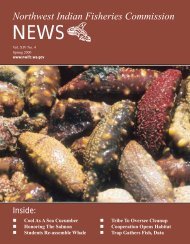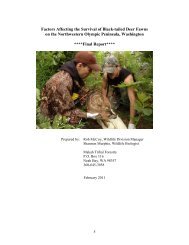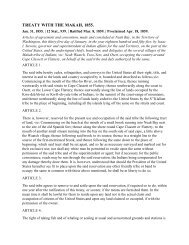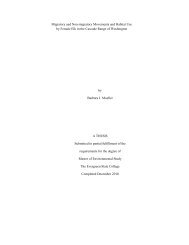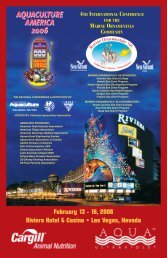DIET, NUTRITION, AND REPRODUCTIVE ... - NWIFC Access
DIET, NUTRITION, AND REPRODUCTIVE ... - NWIFC Access
DIET, NUTRITION, AND REPRODUCTIVE ... - NWIFC Access
You also want an ePaper? Increase the reach of your titles
YUMPU automatically turns print PDFs into web optimized ePapers that Google loves.
26<br />
one time for a complete calf count. There was a significant negative relationship (r 2 =<br />
0.83, P = 0.03, Figure 2) between number of cows seen and calf:cow ratio. This<br />
relationship indicated that the highest calf:cow ratio was observed when the fewest cows<br />
were visible. Counts were standardized to 20 cows to calculate calf:cow ratios for herd 9.<br />
Constant cow survival was assumed for all herds because no radio-collared elk were lost<br />
in 2001, and the same number of cows were repeatedly counted for 7 of the nine herds.<br />
Five herds had mean calf:cow ratios greater than 0.43, significantly greater than<br />
two herds with the lowest mean calf:cow ratios (H = 38.1, n = 9, P < 0.001, df = 8, Table<br />
1). Five of nine herds had December calf:cow ratio greater than 0.3, were in the highly<br />
productive group, and had productivity indices of 5 to 9 (Table 1). Of the five herds in<br />
the highly productive group, three had at least 75% calf survival and December calf:cow<br />
ratio of at least 0.45 (Table 1). Four of nine herds had December calf:cow ratios less than<br />
0.3, were in the less productive group, and had productivity indices of 1 to 4 (Table 1).<br />
Vegetation Type Used and Available<br />
Vegetation type was correctly classified for 94.4 % of groundtruth points, and<br />
timber stand age was correctly classified for 97.7% of groundtruth points (n = 36). The<br />
95% probability circles around each radio-location had a radius of 338m. Average home<br />
range size was 29.3 ± 7.6 km 2 (15 to 50 locations for each herd; Appendix D). Home<br />
range size was not different between years 2000 (24.4 ± 4.8 km 2 ) and 2001 (33.7 ± 9.1<br />
km 2 , t = 1.94, P = 0.1, n = 7). There was no home range overlap in five of nine herds,<br />
and two pairs of herds had small areas of home range overlap.



